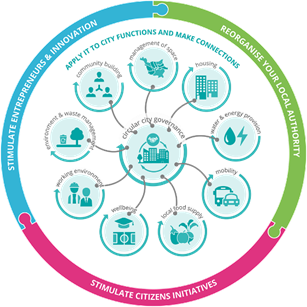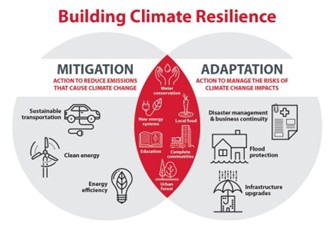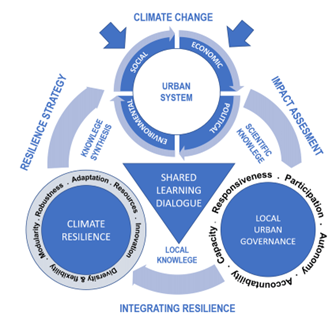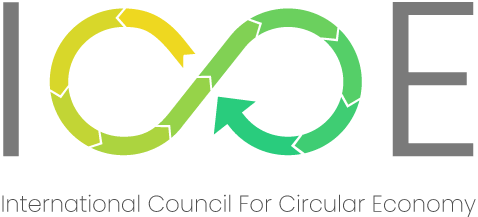A Blueprint for Sustainable Urban Living
ॐ प्रकृति रक्षति रक्षितः
“Prakriti Rakshati Rakshita.” (Nature protects if she is protected.)
This ancient Sanskrit adage encapsulates a profound truth: humanity’s well-being is intrinsically linked to the health of the environment. In the context of modern India’s aspirations, it is a guiding principle, urging us to embrace circularity and transform our urban landscapes into models of sustainable prosperity.
India’s Dual Imperative: Growth and Sustainability for Viksit Bharat 2047
India, the world’s most populous country and fastest-growing major economy, stands at a pivotal juncture. Its ambition for Viksit Bharat Goals 2047 envisions a developed India, but this journey unfolds against a backdrop of escalating climate crises and pervasive environmental degradation. India faces a profound dual imperative of sustaining robust growth and uplifting millions, while concurrently safeguarding its priceless natural capital and ensuring a high quality of life.
The rhythm of India’s progress often beats fastest in its cities, the vibrant hubs of opportunity. However, this rapid urbanization, with an estimated 40% of India’s population expected to live in urban areas by 2030, will fuel economic expansion but will also lead to a voracious appetite for resources, generating immense waste and significantly contributing to greenhouse gas emissions. Given that, India is already on the frontline of climate vulnerability, witnessing intensified heatwaves and devastating urban floods between March and May 2024, India endured heatwaves for 54 days, while lightning, floods, and landslides affected 71 and 40 days, respectively[1], that cause billions in economic losses. This escalating environmental volatility directly imperils the developmental gains.
As Prime Minister Narendra Modi articulated, “For India, climate change is not just a policy issue, but a matter of deep conviction and tradition. We have always lived in harmony with nature.”
This conviction, reinforced by the LiFE (Lifestyle for Environment) movement, must now translate into a new blueprint for urban living.
But can India achieve developed status without fundamentally rethinking its relationship with resources?
The answer lies in a paradigm shift: from the linear “extract-use-dispose” model to integrated, regenerative strategies. This article posits that circular cities are the vanguard for realizing the Viksit Bharat dream.
By embedding deep circularity, enhancing robust climate resilience, implementing transformative policies, empowering governance, and facilitating equitable risk sharing, while carefully addressing the rising costs of pollution, India can create a path that is not only prosperous but also truly sustainable, fulfilling both national hopes and global commitments.
[1] DTE Staff, & DTE Staff. (2025, February 21). Extreme weather events in India 2024: Heatwaves, avoidable deaths and an uncertain future. Down to Earth. https://www.downtoearth.org.in/climate-change/extreme-weather-events-in-india-2024-heatwaves-avoidable-deaths-and-an-uncertain-future.
Circular Cities: Blueprint for Viksit Bharat’s Urban Transformation
Realizing Viksit Bharat Goals 2047 demands a fundamental re-evaluation of urban spaces. The urgent shift to circular cities, i.e., a regenerative urban system where resources are continuously reused, waste and pollution are designed out, and natural systems are regenerated, is much needed.
Circularity reimagines urban resource flows by designing for durability, promoting reuse and repair, comprehensive recycling, local sourcing, and industrial symbiosis. This systemic shift reduces greenhouse gas emissions and minimizes landfill waste. Economically, it drives resource efficiency, creates new green jobs, and reduces reliance on volatile virgin material markets. Socially, it nurtures healthier environments, improves equitable resource access, and empowers communities. As per the report by the Impact Organization, “Circle Economy” -Circular economy strategies can cut global greenhouse gas emissions by 39% and play a crucial role in avoiding climate breakdown.
This understanding of circularity also finds a profound echo in ancient Indian wisdom:
ईशावास्यमिदँ सर्वं यत्किञ्च जगत्यां जगत्। तेन त्यक्तेन भुञ्जीथा मा गृधः कस्यस्विद्धनम्।।
“All this, whatsoever moves in this moving world, is pervaded by God. Therefore, enjoy it by renouncing it. Do not covet what belongs to others.”
This verse, traditionally interpreted as promoting non-attachment and selfless action, offers a powerful philosophical foundation for circularity. “Enjoy it by renouncing it” can be understood as utilizing resources wisely, allowing them to flow back into cycles rather than possessing them permanently or depleting them. It urges us to share and circulate resources, a core tenet for a prosperous and equitable circular city.
A circular city, in principle, is a functional urban area that operates on circular economy principles. While any city can strive to be circular by integrating circular design principles, ensuring minimal waste, and promoting renewable energy, an ideal “Circular City” envisions a thriving urban ecosystem where:
- Waste is a Resource: Everything from building demolition debris to daily household refuse is seen as a valuable input with materials constantly flowing back into the economy.
- Energy is Renewable and Local: The city runs predominantly on decentralized renewable energy sources like rooftop solar, thereby minimizing reliance on fossil fuels and external grids.
- Water is Closed-Loop: Interventions focusing on rainwater harvesting, greywater recycling, and wastewater treatment are implemented for reducing freshwater demand and wastage.
- Green Infrastructure Flourishes: Extensive urban forests, green roofs, permeable surfaces, and bioswales are integral, enhancing biodiversity, mitigating heat islands, managing stormwater, and improving air quality.
- Mobility is Shared and Electric: Public transport is seamless and electric, complemented by shared electric vehicles and extensive pedestrian/cycling networks, minimizing congestion and emissions.
- Community is Engaged: Citizens are active participants, empowered with information and tools for sustainable living. New business models thrive around repair, reuse, and shared services, fostering local economies.

However, achieving the circular vision across India’s varied urban landscape demands tailored approaches. This is due to inherent differences in cities’ infrastructure maturity, population density, and growth patterns, which present unique challenges and opportunities. Some of the approaches for achieving circularity for different urban contexts are discussed below:
- Tier 1 Cities: These are large, mature, densely populated cities with complex legacy infrastructure and entrenched systems. Circularity here should focus on retrofitting and systemic transformation through:
- Decentralized Waste Management: Implementing advanced source segregation, in-situ composting, and material recovery facilities to divert waste from landfills.
- Infrastructure Upgrades: Modernizing existing water networks for leak detection, wastewater treatment for recycling, and integrating smart grid technologies for energy efficiency.
- Industrial Symbiosis: Promoting circular economy principles in existing industrial clusters, fostering material exchange and resource sharing between businesses.
- Behavioral Change Campaigns: Large-scale public awareness and engagement programs to drive sustainable consumption and disposal habits.
- Optimizing Urban Logistics: Implementing efficient reverse logistics for product takebacks and optimizing transport for resource flows.
- Tier 2 Cities: These cities are experiencing rapid growth, often with more available land for new development and less rigid existing infrastructure. Circularity here should focus on proactive integration and planned development through:
- Circular Master Planning: Embedding circular economy principles from the outset in new urban expansion plans and special development zones.
- Eco-Industrial Parks: Developing new industrial areas where businesses are designed for symbiotic relationships, sharing resources and outputs.
- Local Resource Loops: Emphasizing local and closed-loop material cycles and fostering local repair and remanufacturing hubs.
- Nature-Based Solutions: Integrating extensive green infrastructure and natural systems into urban design from the planning stage.
- Smart and Green Infrastructure: Building new infrastructure (e.g., smart water grids, integrated transport systems) with circularity and energy efficiency as core design parameters.
While these distinct strategies are essential for different urban contexts, their effective implementation fundamentally depends on robust policies and effective governance. This is exemplified at the national level by initiatives like the Swachh Bharat Mission (SBM-U), which has laid foundational groundwork for waste management and shifted mindsets. Similarly, Extended Producer Responsibility (EPR) norms now actively push manufacturers towards circular thinking, while programs such as the GOBAR-Dhan Scheme champion bioresource management. Furthermore, the Smart Cities Mission, particularly through initiatives like CITIIS 2.0, provides crucial platforms for innovative urban solutions embracing sustainable and circular practices.
For successful scaling, policies must be cohesive and transcend departmental silos, offering clear regulatory frameworks, potent economic incentives, and robust enforcement. Effective governance is paramount, facilitating seamless multi-stakeholder collaboration among municipal bodies, industries, research institutions, and citizens. This combined force ensures circularity becomes a lived reality, thereby mitigating environmental degradation and bolstering progress towards Viksit Bharat Goals 2047.
Climate Resilience & Governance in Circular Cities
Indian cities, teeming with life and economic activity, are on the frontline of climate vulnerability. Recent decades have bear witness to a marked increase in the frequency and intensity of extreme weather events: from devastating floods in urban centers like Chennai and Mumbai, which cause billions of dollars in economic losses annually, to prolonged droughts impacting agricultural productivity and water security in regions like Rajasthan, and severe heatwaves claiming lives across the subcontinent. According to the “Heat Watch 2024” report, titled Struck by Heat: A News Analysis of Heat Stroke Deaths in India in 2024, between March and June, 733 deaths due to heatstroke were reported across 17 states in India.[1] Air pollution in India resulted in 1.67 million deaths in 2019—the largest pollution-related death toll in any country in the world—and also accounted for $36.8 billion in economic losses, according to a new study led by researchers from the Global Observatory on Pollution and Health at Boston College, the Indian Council of Medical Research, and the Public Health Foundation of India. This underscores the profound human cost, amplifying pollution’s burden.
Fortifying urban centers against these impacts is non-negotiable for Viksit Bharat Goals 2047. Climate resilience—the capacity to anticipate, absorb, adapt, and transform—is a direct investment in prosperity, significantly enhanced by circularity’s resource efficiencies.
Strategies for urban climate resilience must be comprehensive and multi-layered, beginning with fundamental shifts in urban planning and infrastructure development. Investing in green infrastructure within our cities—expansive urban forests that act as carbon sinks and heat sponges, permeable pavements that allow rainwater to percolate rather than flood, bioswales, and green roofs—plays a dual role. It enhances biodiversity and mitigates urban heat island effects, while crucially improving stormwater management, reducing the risk of urban flooding inherent to dense settlements. Furthermore, adapting resilient building codes and regulations is vital, ensuring that new constructions are not only energy-efficient but also flood-resistant and utilize heat-reducing materials.
[1] DTE Staff, & DTE Staff. (2025, February 21). Extreme weather events in India 2024: Heatwaves, avoidable deaths and an uncertain future. Down to Earth. https://www.downtoearth.org.in/climate-change/extreme-weather-events-in-india-2024-heatwaves-avoidable-deaths-and-an-uncertain-future

For effective implementation of climate resilient strategies, the National and sub-national policies must mandate comprehensive climate risk assessments for urban infrastructure, integrate adaptation into urban master plans, and provide financial incentives for resilient development.
Critically, the deployment of innovative technologies like Digital Twins—virtual replicas of physical assets, systems, or even entire cities—can revolutionize this. By integrating real-time data from sensors and urban systems, digital twins enable predictive modeling of climate impacts (e.g., flood trajectories, heat stress patterns), precise monitoring of infrastructure performance, and scenario planning for interventions. This enhances transparency, allows for proactive decision-making, and significantly improves risk preparedness and response capabilities.
Strengthening local governance capacity is also paramount; municipal bodies require enhanced technical expertise, greater financial autonomy, and seamless inter-agency coordination to translate national compliances and commitments into actionable local strategies. By strategically combining policy directives with community engagement and innovation, India can systematically build cities that are not just economically vibrant but also ecologically secure and truly livable.
Risk Sharing & Climate Finance for Circularity & Resilience
The effective realization of these climate-resilient and circular urban development strategies, empowered by robust policy, unwavering governance, and transformative technology, inevitably comes with a substantial financial imperative.
Both climate change mitigation and adaptation demand huge investments. The funding gap is staggering; estimates suggest that developing countries, including India, could require hundreds of billions of dollars annually for adaptation alone, with figures ranging from $187 billion to $359 billion per year. “Where will this capital come from?” is the critical question. Thus, to meet India’s ambitious climate agenda, unprecedented financial mobilization becomes crucial, underpinned by innovative climate finance strategies and effective risk-sharing mechanisms.
Risk sharing distributes financial, technological, and operational burdens across governments, private enterprises, and multilateral institutions. This approach helps de-risk investments, attracts private capital, and leverages diverse expertise for circular cities projects.
Key mechanisms for climate finance and risk sharing include:
- Public-Private Partnerships (PPPs): Leveraging private sector efficiency and capital for resilient urban infrastructure.
- Adaptation Finance: Dedicated funding streams for strengthening critical urban infrastructure, resilient agriculture, and social safety nets.
- Innovative Financing: Instruments like India’s sovereign Green Bonds, sustainability-linked loans, blended finance, and carbon credits generate revenue for climate action, linking to environmental compliances and commitments.
The development and adoption of a robust Climate Taxonomy are crucial here. This taxonomy provides a standardized classification system for environmentally sustainable economic activities, enabling investors and policymakers to accurately identify and channelize the capital towards genuine green investments. It enhances transparency, prevents greenwashing, and ensures that financial flows are effectively directed to climate-resilient and circular urban projects.
- International Cooperation: Developed nations are crucial, fulfilling global compliances and commitments, and supporting technology transfer. India, as a leading voice for the Global South, consistently advocates for equitable climate finance and technology transfer
Robust policies and transparent governance are vital, with clear regulatory frameworks, investor confidence, equitable risk sharing, and efficient fund allocation to drive climate resilience, energy transition, and circularity towards Viksit Bharat Goals 2047.
To ensure the efficacy of these financial mechanisms, the government must develop clear regulatory frameworks that streamline project approvals, provide investor confidence, and ensure equitable risk sharing. Furthermore, strong governance structures are needed for efficient fund allocation, project oversight, and rigorous monitoring to ensure that investments deliver intended climate and development outcomes.
Weaving Sustainability: Embedding Circularity, Policies, and Governance
Achieving Viksit Bharat Goals 2047, fostering climate resilience, driving energy transition, and mitigating pollution costs all converge on one transformative principle: embedding circularity into development, with circular cities as its clearest manifestation. This requires a shift from reactive sustainability to proactive value creation, building long-term resilience and innovation. The guiding question for every innovation must be:
‘Are we truly designing for a future where nothing is wasted?’
Embedding circularity requires a holistic rethink of operations. Key elements include:
- Governance & Leadership: Board-level accountability and integration of circular goals into core business strategies, providing vision for urban planning and greenfield cities.
- Operating Model Innovation: Designing out waste and pollution, developing products for durability/repairability, shifting to Product-as-a-Service, and fostering industrial symbiosis.
- Talent & Skills Development: Building new competencies in circular design, material recovery, and circular business models, extending to public sector capacity for urban policies and governance.
- Financial Strategy: Aligning capital allocation with circular ambitions, valuing natural capital, and attracting sustainable finance (green bonds, sustainability-linked loans).
- Supply Chain Management: Transparency and collaboration for sustainable sourcing, product lifecycle assessments, and closed-loop material flows.
- Risk Management: Integrating environmental and resource risks into enterprise frameworks to build resilience through circular strategies.
The overarching role of policies and governance is crucial. Comprehensive national policies (like India’s Draft National Circular Economy Framework ) create an enabling environment. Effective governance ensures implementation, monitors compliances and commitments, and fosters innovation and collaboration.
Crucially, India’s journey must evolve from merely adhering to compliances to genuinely embracing commitments. This shift signifies moving beyond minimum requirements to actively seeking leadership in global sustainability. This top-down vision, combined with bottom-up innovation and dedicated governance, ensures circularity becomes systemic, propelling India towards Viksit Bharat Goals 2047 with enhanced resilience, competitive advantage, and a stronger global reputation.

The Path Forward: An Integrated Urban Mandate for Viksit Bharat 2047
India is poised to demonstrate how a rapidly developing nation can achieve high growth while pioneering genuinely green pathways. By integrating circularity as a core operational principle through its circular cities, prioritizing climate resilience and leveraging technologies like Digital Twins, mobilizing climate finance through risk sharing, reducing the societal cost of pollution, and accelerating its energy transition via policies and governance, India can not only meet its Viksit Bharat Goals 2047 but also emerge as a global leader and a beacon of sustainable development for the Global South.
To concretize this vision, India must adopt a multi-pronged, integrated strategic framework focusing on five critical pillars:
- Integrated Circular Resource Management: Systemic changes in urban planning and industrial processes to design out waste and pollution, promoting closed-loop systems for water, materials, and energy. This includes waste management, industrial symbiosis, and reuse/repair economies at city scales.
- Climate-Proofing Urban Infrastructure & Ecosystems: Prioritize investments in adaptive infrastructure and green solutions to enhance urban resilience against extreme weather events, including robust drainage, urban green spaces, and climate-resilient building codes.
- Decentralized Clean Energy Transition: Accelerate renewable energy adoption within urban boundaries, focusing on decentralized generation (rooftop solar, community projects), smart grids, and green mobility to reduce emissions and improve air quality.
- Empowering Policy, Governance & Capacity Building: Develop comprehensive policies with clear regulatory frameworks and incentives for circularity and climate action. Strengthen urban local bodies through enhanced technical capacity, inter-agency coordination, and digital governance tools for effective implementation.
- Innovative Climate Finance & Risk Sharing: Mobilize significant public and private climate finance through mechanisms like green bonds, blended finance, and carbon markets. Foster robust Public-Private Partnerships and risk-sharing models to de-risk large-scale sustainable urban projects.
While the journey ahead is monumental, the resolve of a nation awakening to its full potential is indomitable.
उत्तिष्ठत जाग्रत प्राप्य वरान् निबोधत।
“Arise, awake, and stop not till the goal is reached.”
This ancient call serves as a powerful reminder for India’s path to Viksit Bharat 2047, urging collective action towards a developed, circular, and resilient nation. This is not just an environmental agenda; it is an economic growth strategy, a social equity imperative, and a profound legacy for generations to come.
References:
- Cities and the circular economy. (n.d.). https://www.ellenmacarthurfoundation.org/topics/cities/overview
- Climate Change and Waste Reducing Waste Can Make a Difference. (n.d.). US EPA ARCHIVE DOCUMENT.
- Sidhu, K. (2025, May 25). The goal of “Viksit Bharat” 2047: a national dream or a mere mirage. The KBS Chronicle. https://kbssidhu.substack.com/p/the-goal-of-viksit-bharat-2047-a
- International Budget Partnership. (2023, March 2). Climate finance transparency is vital – and so is avoiding greenwashing. https://internationalbudget.org/climate-finance-transparency-is-vital-and-so-is-avoiding-greenwashing/
- University of Cambridge. (2025, March 14). A strong case for investing in climate mitigation and adaptation to avoid damage to the global economy. https://phys.org/news/2025-03-strong-case-investing-climate-mitigation.html. https://phys.org/news/2025-03-strong-case-investing-climate-mitigation.html
- Peskin, J. (n.d.). Heat waves, droughts cause billions of dollars in global economic losses – Florida Climate Institute. https://floridaclimateinstitute.org/resources/headline-news/3815-heat-waves-droughts-cause-billions-of-dollars-in-global-economic-losses

